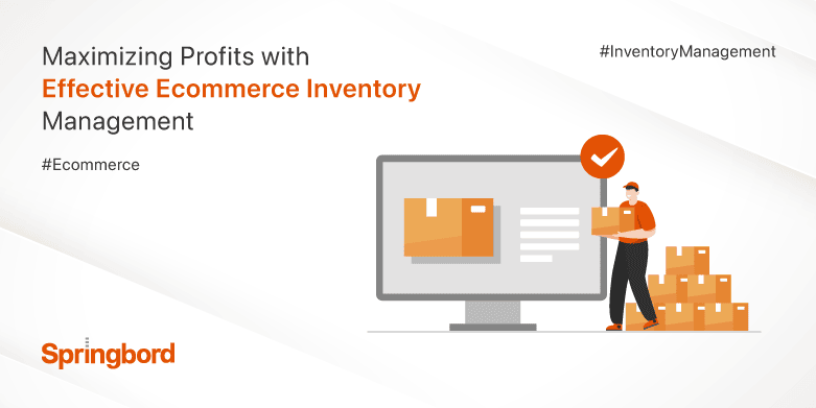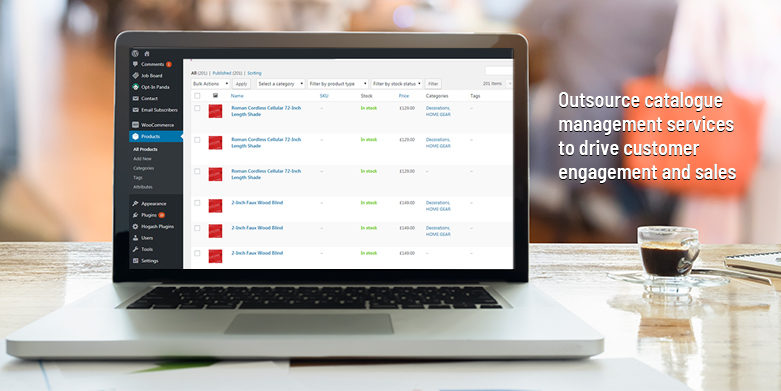 Read time 7 min
Read time 7 minEcommerce inventory management refers to businesses’ processes and strategies to manage their product inventory for online sales. Effective ecommerce inventory management is essential for any online retailer, as it helps to ensure that products are always available to customers while minimizing the costs associated with storing excess inventory.
By optimizing inventory levels and streamlining supply chain processes, ecommerce businesses can maximize profits and maintain a competitive edge in the crowded online marketplace.
Importance of Inventory Management
Inventory management plays a crucial role in the success of any ecommerce business. It refers to tracking and controlling a company’s inventory levels, stock orders, and sales. Effective inventory management is essential for businesses that sell physical goods. It helps them ensure they have the right stock to meet customer demand and minimize waste.
One of the key benefits of effective inventory management is increased profitability. When a business has a clear view of its inventory levels, it can choose when to restock and how much to order. This helps avoid overstocking or understocking, which can negatively impact profitability. Overstocking can lead to additional storage costs while understocking can result in lost sales and dissatisfied customers.
On the other hand, poor inventory management can significantly impact an ecommerce business’s profitability. For instance, if a business overstocks, it may be forced to sell the excess inventory at a discount to clear it out, leading to reduced profit margins. In contrast, understocking can lead to lost sales and potential customers turning to competitors.
Additionally, poor inventory management can result in increased costs due to inefficiencies in the supply chain. For instance, if a business needs a clear view of its
inventory levels, it may order unnecessary stock, leading to additional storage and shipping costs. Similarly, if a business has too much stock on hand, it may have to pay for additional storage space, which can be costly.
So, effective inventory management is critical for the success of ecommerce businesses. It helps businesses meet customer demand, reduce waste, and increase profitability. On the other hand, poor inventory management can negatively impact profitability and result in additional costs, making it crucial for ecommerce businesses to prioritise inventory management.
Best Practices for Ecommerce Inventory Management
To effectively manage inventory for ecommerce businesses, several key principles must be remembered. These include:
Determining Optimal Inventory Levels
Determining optimal inventory levels is one of the most important aspects of effective inventory management. This involves balancing holding enough inventory to meet customer demand and avoiding excess inventory that can tie up resources and increase costs. There are several factors to consider when determining optimal inventory levels, including historical sales data, lead times, and customer demand.
Forecasting Demand
To maintain optimal inventory levels, ecommerce businesses must clearly understand customer demand. This involves analyzing historical sales data, tracking trends and patterns, and monitoring changes in consumer behaviour. By accurately forecasting demand, businesses can avoid stockouts and ensure they always have enough inventory to meet customer needs.
Managing Stockouts
Despite best efforts, stockouts can still occur. When this happens, ecommerce businesses must have the plan to manage stockouts and minimise their impact on customer satisfaction. This can include offering alternative products, providing estimated restock dates, and communicating proactively with customers.
Regular Inventory Audits and Adjustments
Regular inventory audits ensure that inventory levels remain optimized over time. By regularly reviewing inventory levels and sales data, businesses can identify trends and adjust their inventory levels accordingly. This helps avoid excess inventory and reduce carrying costs while ensuring enough inventory is available to meet demand.
So overall, effective ecommerce inventory management is essential for the success of any online retailer. Businesses can maximize profits and maintain a competitive edge in the online marketplace by optimizing inventory levels, forecasting demand, managing stockouts, and conducting regular inventory audits. By following these best practices, ecommerce businesses can ensure they always have the right products in stock, at the right time, and in the right quantities while minimizing the costs associated with excess inventory.
Technology Tools for Effective Ecommerce Inventory Management
Inventory management can be a complex and time-consuming task for ecommerce businesses. Fortunately, technology has made it easier to manage inventory efficiently and effectively. Here are some technology tools that can help streamline ecommerce inventory management:
Inventory Management Software
Inventory management software is a tool that can help ecommerce businesses keep track of their inventory levels and movements. These software solutions can help automate tasks such as tracking inventory levels, updating stock counts, and generating purchase orders. Some popular examples of inventory management software for ecommerce businesses include TradeGecko, Zoho Inventory, and Stitch Labs.
Barcode Scanners
Barcode scanners can help ecommerce businesses streamline their inventory management process by quickly scanning products and updating inventory levels in real time. This can save time and reduce errors associated with manual data entry.
Point of Sale Systems
Point of sale (POS) systems can help ecommerce businesses manage their inventory by tracking sales data and inventory levels in real-time. POS systems can help automate tasks such as updating inventory levels, generating purchase orders, and tracking sales trends. Popular POS systems for ecommerce businesses include Shopify, Square, and Lightspeed.
Warehouse Management Systems
Warehouse management systems (WMS) can help ecommerce businesses manage their inventory by tracking inventory levels, movements, and locations. WMS can help automate tasks such as picking, packing, shipping orders and tracking inventory levels in real-time. Popular examples of WMS for ecommerce businesses include Fishbowl and SkuVault.
Technology tools can help ecommerce businesses streamline their inventory management processes and reduce errors associated with manual data entry. These tools can also help businesses make data-driven decisions to enhance inventory levels and profitability.
Challenges of E-commerce Inventory Management
Managing inventory can be challenging for ecommerce businesses, especially as they grow and expand. Here are some common challenges ecommerce businesses face when managing their inventory:
Stockouts
Stockouts occur when ecommerce businesses run out of inventory for a particular product. This can lead to lost sales, dissatisfied customers, and reduced profitability. Stockouts can occur due to inaccurate demand forecasting, supply chain disruptions, or inadequate inventory levels.
Overstocking
Overstocking occurs when ecommerce businesses need more inventory for a particular product. This can tie up capital, increase storage costs, and lead to obsolete inventory. Overstocking can occur due to inaccurate demand forecasting, excessive purchasing, or slow-moving products.
Inaccurate Inventory Records
Inaccurate inventory records can lead to a host of problems for ecommerce businesses. These problems include stockouts, overstocking, incorrect order fulfilment, and lost sales. Inaccurate inventory records can occur due to manual data entry errors, system glitches, or theft.
To overcome these challenges, ecommerce businesses can use outsourcing and automation. Outsourcing can help businesses manage their inventory more efficiently by delegating tasks such as warehousing and fulfilment to third-party logistics providers (3PLs). Automation can help businesses streamline their inventory management processes using technology tools such as inventory management software and barcode scanners.
The Role of Data in Ecommerce Inventory Management
Data can play a critical role in ecommerce inventory management by helping businesses make relevant decisions about their inventory levels and movements. Here are some ways data can help ecommerce businesses optimize their inventory management:
Tracking Sales Data
Tracking sales data can help ecommerce businesses identify which products are selling well and which products are not. This can help businesses decide which products to stock and which to discontinue. Sales data can also help businesses forecast future demand and plan their inventory levels accordingly.
Customer Behavior
Tracking customer behaviour can help ecommerce businesses understand customers’ preferences, shopping patterns, and buying habits. This can help businesses decide which products to keep and how much inventory to hold. For example, suppose a business sees that a particular product is frequently purchased with another product. In that case, they should ensure that both products are always in stock to increase the likelihood of selling both items in one order.
Optimizing Inventory Levels
By tracking sales data and customer behaviour, ecommerce businesses can optimize their inventory levels to minimize stockouts and overstocking. For example, if a business sees that a particular product is selling quickly, it may want to increase its inventory levels for that product to avoid stockouts. On the other hand, if a business sees that a particular product is not selling well, it may want to decrease its inventory levels to avoid overstocking.
Data can be collected and analyzed through various technology tools, such as inventory management software and POS systems. Using these tools to track and analyze data, ecommerce businesses can make apt decisions about their inventory levels and other factors, ultimately improving their profitability.
Wrap Up
So, inventory management is critical to running a successful ecommerce business. Technology tools such as inventory management software, barcode scanners, POS systems, and WMS can help ecommerce businesses streamline their inventory management processes and reduce errors.
However, ecommerce businesses still need help with stockouts, overstocking, and inaccurate inventory records. To overcome these challenges, businesses can use strategies such as outsourcing and automation. By tracking sales data and customer behavior, ecommerce businesses can decide their inventory levels and movements, ultimately improving their profitability.
Get All the Benefits of Springbord’s Effective Inventory Management
Effective inventory management is a crucial aspect of maximizing profits in ecommerce. At Springbord, we understand the importance of having the right products in stock at the right time and in quantity. Our team of experts with vast knowledge of ecommerce can help you manage your inventory management processes, reduce costs, and increase sales.
From forecasting and planning to order fulfillment and logistics, we offer a range of ecommerce services personalized to provide your industry-specific management. Don’t let inventory management hold you back from reaching your full capacity. Partner with Springbord today and get all the benefits we can offer. Contact us to learn how we can help you with effective inventory management processes.







